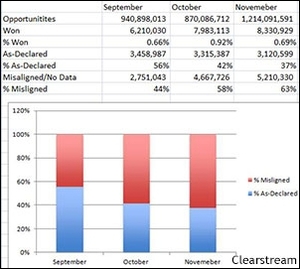 Every week, it seems a new report comes
out telling marketers that half of the ads they buy are squandered due to fraud, viewability, or some other wasteful mean.
Every week, it seems a new report comes
out telling marketers that half of the ads they buy are squandered due to fraud, viewability, or some other wasteful mean.
This week is no different, as Clearstream, a video ad
targeting platform, has released a new study claiming that 55% of video ads bought via real-time bidding (RTB) are “misaligned.”
“I wouldn’t call it fraud,” said
Brian Mandelbaum, founder of Clearstream. “But I would say that the buyer did not buy what they intended in the auction.”
Clearstream studied over three billion video ad
impressions a set of its advertiser clients bought via its platform in September, October and November. In that span, 22.5 million auctions were won, and Clearstream analyzed the inventory
post-auction to see if the ad unit aligned with what the SSP or exchange said.
advertisement
advertisement
In other words, if the RTB marketplace said a video ad on XYZ.com was 600x400 in size, in the U.S., supported
flash and was above the fold -- but the advertiser bought it and the unit was in the UK, Clearstream counted it as a “misaligned” impression. The company claims that 55% of all ads studied
contained at least one “misaligned” data point, or no data at all. False domains was the number one misalignment.
Clearstream declined to say which SSPs or exchanges it studied,
but Mandelbaum said the campaigns they pulled data from spanned across all open exchanges and included some private marketplaces as well. He also said over 50% of the inventory included in the
research came from comScore 500 publishers.
Mandelbaum also declined to reveal any brands that were directly impacted by the “misaligned” data. He did say that the issue was
unrelated to specific verticals. The company also has technology that attempts to address post-bid issues, but Mandelbaum claimed the data was not cherry-picked, saying the company “took a
sampling of impressions from various campaigns; an equal sample from each campaign.”
Real-Time Daily spoke with multiple video ad platforms about the issue, and while they
acknowledged that “it certainly does happen,” they claimed that as long as the buyer or DSP has legitimate fraud detection technology and viewability measurement firms working with them,
it is not a dire issue.
Another source told Real-Time Daily that an issue often arises when it comes to definitions. Specifically, definitions about “small”
“medium” and “large” video units. There is no standard definition for video sizes, which is what leads to definitional problems.
Clearstream found that the number of
misaligned impressions steadily increased from September through November. In September, for example, Clearstream found 44% of video ad impressions to be “misaligned.” That number rose to
58% in October and 63% in November. In November, only 3.1 million of the 8.3 million video ads Clearstream sample were “as declared.”
“It’s not meant
to be nefarious,” said Mandelbaum. “There’s just limited data being presented.” He said he was surprised by the results of the study, but coupled with recent viewability and
fraud reports from the likes of Google, Integral Ad Science and Solve Media, the report seems only to confirm recent trends, all of which indicate that the RTB marketplace still has a ways to go
before it's up to par in the quality department.